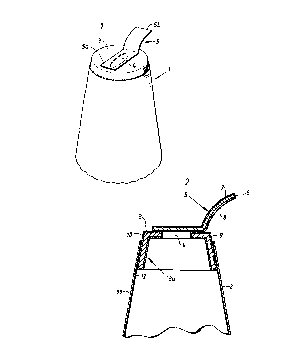Some of the information on this Web page has been provided by external sources. The Government of Canada is not responsible for the accuracy, reliability or currency of the information supplied by external sources. Users wishing to rely upon this information should consult directly with the source of the information. Content provided by external sources is not subject to official languages, privacy and accessibility requirements.
Any discrepancies in the text and image of the Claims and Abstract are due to differing posting times. Text of the Claims and Abstract are posted:
| (12) Patent: | (11) CA 2011319 |
|---|---|
| (54) English Title: | PACKING CONTAINER FOR LIQUID, ESPECIALLY PRESSURIZED CONTENTS |
| (54) French Title: | CONTENANT D'EMBALLAGE POUR LIQUIDE, SURTOUT SOUS PRESSION |
| Status: | Expired and beyond the Period of Reversal |
| (51) International Patent Classification (IPC): |
|
|---|---|
| (72) Inventors : |
|
| (73) Owners : |
|
| (71) Applicants : |
|
| (74) Agent: | MARKS & CLERK |
| (74) Associate agent: | |
| (45) Issued: | 1998-09-15 |
| (22) Filed Date: | 1990-03-02 |
| (41) Open to Public Inspection: | 1990-09-29 |
| Examination requested: | 1992-05-19 |
| Availability of licence: | N/A |
| Dedicated to the Public: | N/A |
| (25) Language of filing: | English |
| Patent Cooperation Treaty (PCT): | No |
|---|
| (30) Application Priority Data: | ||||||
|---|---|---|---|---|---|---|
|
A packing container comprising an end wall (3) and an
emptying opening (4) incorporated in the end wall which is
covered by means of a cover strip (5) applied detachably to
the outside of the end wall. The cover strip (5) as well
as the end wall (3) consist of a plastic-coated metallic
material and are attached to one another along a sealing
joint formed by surface fusion around the whole emptying
opening .
Récipient d'emballage comportant une paroi d'extrémité (3) et une ouverture de vidage (4) incorporée dans la paroi d'extrémité, laquelle est recouverte d'une bande de fermeture (5) appliquée de façon détachable à l'extérieur de la paroi d'extrémité. La bande de fermeture (5) et la paroi d'extrémité (3) sont faites de métal recouvert de plastique et sont rattachées l'une à l'autre le long d'un joint de scellement formé par fusion superficielle sur tout le pourtour de l'ouverture de vidage.
Note: Claims are shown in the official language in which they were submitted.
Note: Descriptions are shown in the official language in which they were submitted.

2024-08-01:As part of the Next Generation Patents (NGP) transition, the Canadian Patents Database (CPD) now contains a more detailed Event History, which replicates the Event Log of our new back-office solution.
Please note that "Inactive:" events refers to events no longer in use in our new back-office solution.
For a clearer understanding of the status of the application/patent presented on this page, the site Disclaimer , as well as the definitions for Patent , Event History , Maintenance Fee and Payment History should be consulted.
| Description | Date |
|---|---|
| Inactive: IPC from MCD | 2006-03-11 |
| Time Limit for Reversal Expired | 2004-03-02 |
| Letter Sent | 2003-03-03 |
| Grant by Issuance | 1998-09-15 |
| Inactive: Final fee received | 1998-04-09 |
| Pre-grant | 1998-04-09 |
| Inactive: Received pages at allowance | 1998-04-09 |
| Notice of Allowance is Issued | 1997-10-22 |
| Notice of Allowance is Issued | 1997-10-22 |
| Letter Sent | 1997-10-22 |
| Inactive: Status info is complete as of Log entry date | 1997-10-15 |
| Inactive: Application prosecuted on TS as of Log entry date | 1997-10-15 |
| Inactive: IPC removed | 1997-08-27 |
| Inactive: First IPC assigned | 1997-08-27 |
| Inactive: IPC assigned | 1997-08-27 |
| Inactive: Approved for allowance (AFA) | 1997-08-13 |
| Request for Examination Requirements Determined Compliant | 1992-05-19 |
| All Requirements for Examination Determined Compliant | 1992-05-19 |
| Application Published (Open to Public Inspection) | 1990-09-29 |
There is no abandonment history.
The last payment was received on 1998-02-17
Note : If the full payment has not been received on or before the date indicated, a further fee may be required which may be one of the following
Please refer to the CIPO Patent Fees web page to see all current fee amounts.
| Fee Type | Anniversary Year | Due Date | Paid Date |
|---|---|---|---|
| MF (application, 8th anniv.) - standard | 08 | 1998-03-02 | 1998-02-17 |
| Final fee - standard | 1998-04-09 | ||
| MF (patent, 9th anniv.) - standard | 1999-03-02 | 1999-02-19 | |
| MF (patent, 10th anniv.) - standard | 2000-03-02 | 2000-02-18 | |
| MF (patent, 11th anniv.) - standard | 2001-03-02 | 2001-02-20 | |
| MF (patent, 12th anniv.) - standard | 2002-03-04 | 2002-02-21 |
Note: Records showing the ownership history in alphabetical order.
| Current Owners on Record |
|---|
| TETRA LAVAL HOLDINGS & FINANCE S.A. |
| Past Owners on Record |
|---|
| BENGT BJORCK |